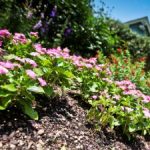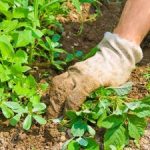Follow this basic recipe and add some of your own ingredients such as pervious pathways, patios, trestles and decks and you’re on your way to a gourmet landscape.
To either a new or an existing landscape add:
- A good amount of native and well adaptive plants – to taste.
- Plants for every season. There are great watersaver plants for each season of the year.
- 2 to 4 inches of mulch in beds (mulch should not come in contact with tree trunks)
- 4 to 6 inches soil
- A handful of maintenance
- A little turf if needed
- A little water, mainly in the summer and right after planting new plants. Generally, the less turf the less water needed.
- A good shade tree or two – if you’re lucky this came with your landscape as an existing tree.
The Balanced Design Idea
Put your landscape on a turf diet with the “One Third” approach to landscape design. Plan to have 1/3 turf, 1/3 planting beds, and 1/3 hardscape. When possible, choose pervious hardscapes over impervious ones such as concrete patios or mortared brick. Pervious hardscapes are constructed to let water penetrate the ground. Good examples are flagstone set in sand, wooden decks, or decomposed granite pathways. When deciding on where to place turf think about what you are going to use it for and install it only where it meets a need. Be sure to choose the right variety for the conditions like sun and foot traffic.
Go Ahead, Go Wild!
Imagine butterflies filling your backyard with moving color, or witness the arrival of birds settling in for the winter. You can add ingredients to your gourmet landscape and turn it into a feast for wildlife too.
The basic ingredients to a great wildscape:
Food – Select plants that provide a variety of seeds, buds, fruit, nectar and pollen. Winter food is especially important so include plants with berries.
Water – Water! Yes, water. You’ll be saving so much water from reduced irrigation needs that you can afford to have a bird bath, shallow-wide brimmed dish or pond. Place water away from thick brush so birds can’t be ambushed by the neighbor’s cat.
Cover – Wildlife needs shelter. Densely branched shrubs, understory, hollow logs, small brush piles and trees of various sizes provide feeding, cover and nesting opportunities for many species.
A Place to Raise Young – To complete your habitat, provide special areas for courtship and a place to raise young. Bird houses and nesting shelves are good in the absence of dense cover. Also, be sure to keep cats inside, especially during the spring when baby birds are fledging.
Predation vs. Pesticides – A carefully planned wildscape will have no need for pesticides, herbicides and fertilizers. Select and maintain pest resistant plants. Native plants generally have fewer pest problems. Use organic gardening techniques. Learn to recognize and care for your natural pest controllers: ladybugs, wasps, birds and bats. If you must intervene, hand remove pests, or spray with water. If you must use pesticides, start with the least toxic and use with care. They not only kill “bad” bugs but good ones too and also contribute to pollution in our rivers, creeks and ground water when misused. Control weeds with liberal mulching, dense planting and proper soil care.




